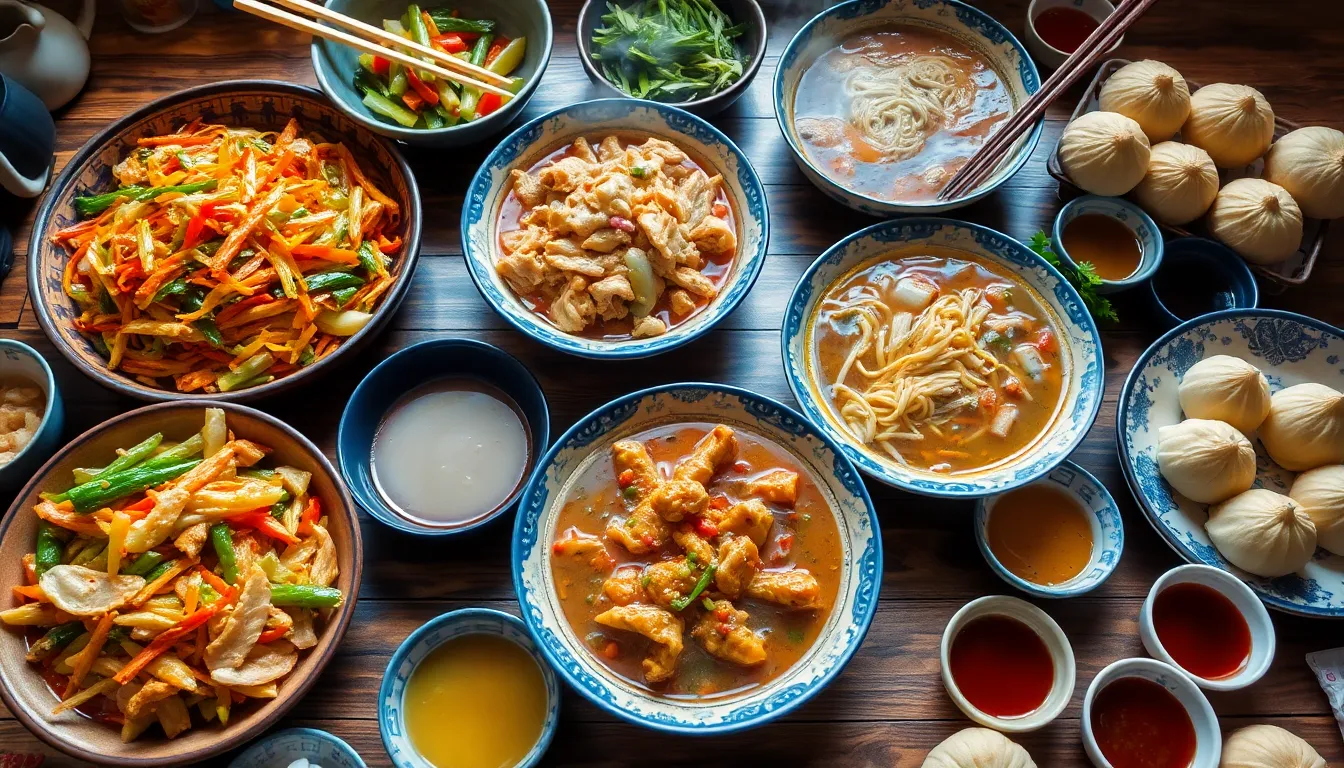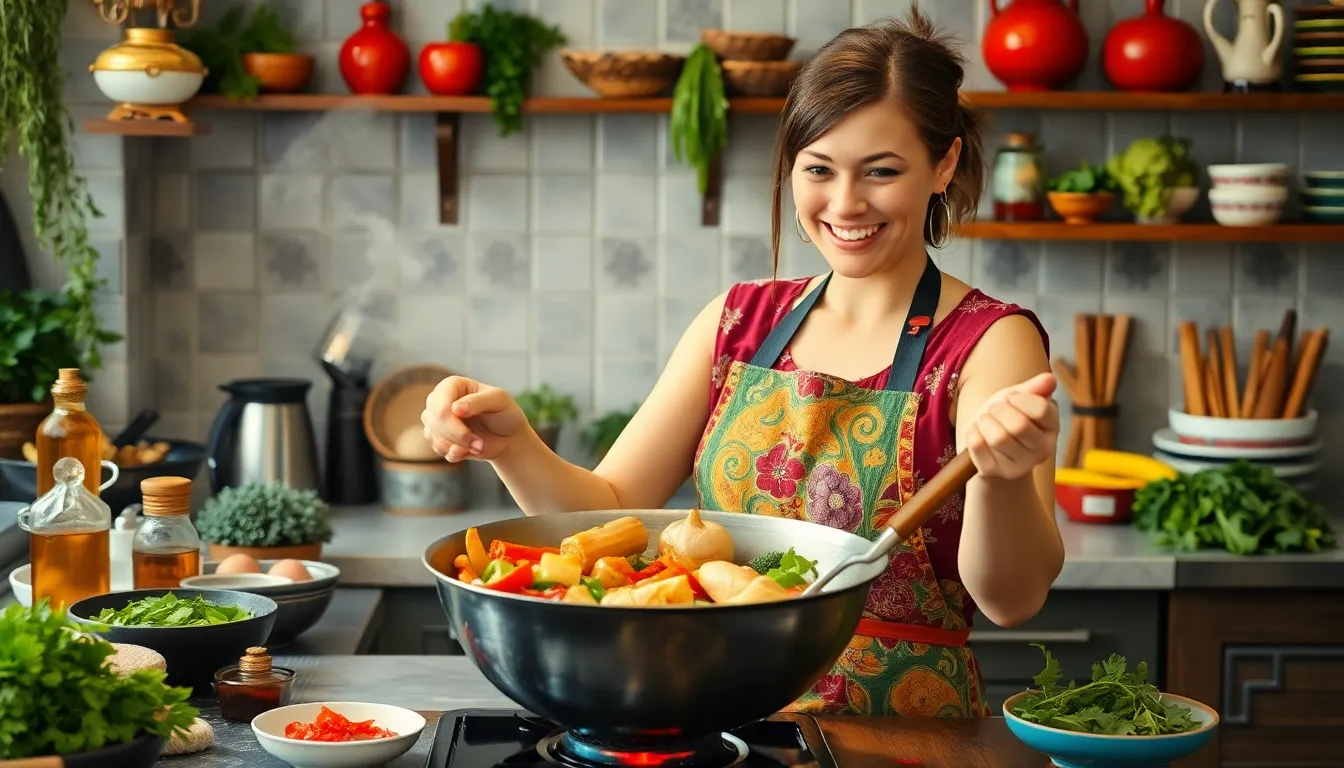Craving a culinary adventure that’ll take your taste buds on a joyride? Look no further than the vibrant world of Chinese recipes! With flavors that dance on the palate and aromas that’ll have you drooling faster than you can say “dim sum,” there’s no shortage of delicious dishes to explore.
Table of Contents
ToggleOverview of Chinese Recipes
Chinese recipes showcase a diverse range of ingredients and cooking techniques. The culinary landscape includes vibrant flavors and textures that captivate food enthusiasts. Different regional cuisines, such as Sichuan and Cantonese, offer distinct characteristics and signature dishes.
Staple ingredients feature rice, noodles, vegetables, and proteins like chicken, pork, and seafood. Each ingredient plays a crucial role in creating balanced meals infused with spices and sauces. Techniques such as stir-frying, steaming, and braising highlight the versatility found in Chinese cooking.
Noodle dishes like Chow Mein and Hot Pot illustrate the popularity of this staple food. In contrast, dumplings like Jiaozi represent traditional favorites enjoyed during festivals. Stir-fried dishes highlight the quick cooking method that retains nutrients and flavors.
Rich sauces, like soy sauce and hoisin sauce, enhance various dishes. Meals often balance sweet, salty, and spicy flavors, appealing to a range of palates. Common dishes encompass Kung Pao Chicken, Mapo Tofu, and Sweet and Sour Pork, each with unique taste profiles and textures.
Vegetarian recipes also thrive in Chinese cuisine, emphasizing fresh vegetables and tofu. Popular dishes include Buddha’s Delight, incorporating a variety of vegetables, and stir-fried tofu with greens. Desserts, while less commonly seen, include sweet treats like Mooncakes and Sesame Balls.
Cooking Chinese recipes invites both creativity and tradition. Home cooks often adapt flavors and ingredients based on personal preferences and regional availability. By exploring this rich culinary heritage, individuals can experience the depth and complexity of Chinese cuisine.
Popular Chinese Dishes

Chinese cuisine offers a vast array of popular dishes that showcase its rich cultural heritage and bold flavors. This section highlights notable recipes that define the culinary landscape.
Stir-Fry Recipes
Stir-frying represents a quintessential Chinese cooking technique. Vegetables like bok choy and bell peppers combine with proteins such as chicken or beef. Common sauces, including soy and oyster sauce, enhance the flavors. Typical stir-fry dishes include Beef with Broccoli and Kung Pao Chicken, both enjoyed worldwide. Quick cooking preserves the vibrant colors and crunch of ingredients, making stir-fry a favorite for home cooks seeking nutritious meals.
Noodle Dishes
Noodle dishes embody versatility and dedication in Chinese cuisine. Popular types include Chow Mein and Dan Dan Noodles, recognized for their unique textures and tastes. Ingredients like scallions and sesame oil add depth to these recipes. Broth-based noodle soups, such as Beef Noodle Soup, offer warmth and comfort. Noodles also serve as a staple in many regional specialties, displaying a balance of flavors and cultural influences.
Dumplings and Buns
Dumplings and buns signify tradition in Chinese culinary practice. Jiaozi, filled with ground meat and vegetables, features prominently in celebrations. Steamed buns, or Baozi, provide a fluffy texture and often contain savory fillings like pork or red bean. Dipping sauces like vinegar and chili oil further enhance these dishes. Enjoying dumplings and buns fosters a communal dining experience, perfect for gatherings and feasts.
Ingredients Commonly Used
Chinese cuisine boasts a variety of ingredients that shape its unique flavors and textures. Ingredients form the backbone of many dishes, enhancing the culinary experience.
Fresh Herbs and Spices
Fresh herbs and spices elevate the taste of Chinese dishes. Common ingredients include garlic, ginger, and scallions, which add depth and brightness. Cilantro offers a fresh finish, while star anise and Sichuan peppercorns introduce aromatic complexity. Basil varieties, particularly Thai basil, contribute a sweet aroma to stir-fried recipes. Many recipes utilize these herbs and spices, enhancing the overall flavor profile.
Sauces and Condiments
Sauces and condiments play a vital role in achieving authentic Chinese flavors. Soy sauce stands as a staple, providing saltiness and umami. Oyster sauce adds a rich depth, while hoisin sauce contributes sweetness and spice. Chili oil infuses heat, appealing to those who enjoy bold flavors. Many dishes depend on these key sauces to create signature tastes that define Chinese cooking.
Grains and Noodles
Grains and noodles form the foundation of many Chinese meals. Rice serves as a staple, providing a base for countless dishes. Varieties such as jasmine and sticky rice offer unique tastes and textures. Noodles, like wheat and rice noodles, feature prominently in stir-fries and soups. Dishes such as Chow Mein and Dan Dan Noodles exemplify how these ingredients create satisfying meals that highlight cultural significance.
Cooking Techniques
Chinese cuisine employs various cooking techniques that enhance flavors and textures in dishes. Mastery of these methods helps achieve authentic results.
Steaming
Steaming stands out as a healthy cooking technique. This method preserves nutrients and flavors effectively. Dim sum and fish shine when steamed, revealing their natural goodness. Equipment needed includes a bamboo steamer or a metal steaming basket. Cookers often use water or broth to infuse additional taste. Steaming ensures even cooking while maintaining moisture, making it perfect for vegetables and delicate proteins.
Stir-Frying
Stir-frying involves quick cooking over high heat, using a small amount of oil. This technique brings vibrant colors and crisp textures to ingredients. Wok versatility allows for rapid heat distribution, which enhances flavor profiles. Essential ingredients like garlic, ginger, and sauces contribute to dish complexity. Popular stir-fry recipes include Kung Pao Chicken and Beef with Broccoli. Cooks often prefer bite-sized pieces for quicker cooking and even flavors throughout.
Braising
Braising combines both moist and dry heat, to develop rich flavors over time. This technique resembles stewing but uses less liquid. Meats and vegetables tenderize, absorbing seasoning as they slowly cook. Ingredients often benefit from an initial sear before adding broth or sauce. Dishes such as red-cooked pork and braised cabbage showcase the technique’s depth. Braising promotes a warm, comforting feel, perfect for communal dining experiences.
Exploring Chinese recipes opens up a world of culinary delights that excite the senses. Each dish tells a story of tradition and innovation, inviting everyone to experience the rich tapestry of flavors and textures. From the vibrant stir-fries to the comforting noodle soups, there’s something for every palate.
Home cooks can enjoy the flexibility of adapting these recipes to suit their tastes while honoring the essence of Chinese cuisine. With each meal prepared, they not only nourish the body but also connect with a rich cultural heritage. The journey through Chinese cooking is as rewarding as it is delicious, making it a cherished experience for all who partake.




